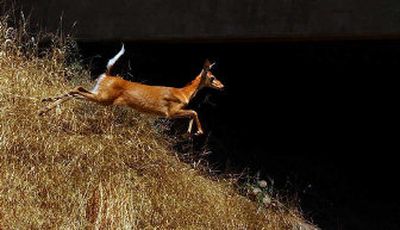Deer dilemma

Kelli and Mike Cordon awoke with a start after hearing the sound of something frantically scraping on the concrete just outside their home on Sundown Drive. It was the middle of the night a few months ago and out in their backyard the Cordon’s found a young deer stranded atop their pool tarp, trying to claw its way out of their pool. Kelli initially rushed toward the deer to help it, but was stopped by Mike and instead they freed the animal by pulling the pool cover with the animal atop it to solid ground.
The pool incident highlights a growing and concerning trend around much of Coeur d’Alene. As human development continues to expand into the surrounding countryside, conflicts between humans and wildlife is on the rise. In many places urban wildlife has become part of everyday life. For some, having deer in the yard is a treat and they encourage the animals by feeding them. But for others, deer and the damage they cause to trees and landscaping is an expensive nuisance.
To help manage the dilemma, the Idaho Department of Fish and Game will soon offer residents from each Kootenai County municipality the chance to get together to voice their concerns and explore options for dealing with urban wildlife. Fish and Game biologist Mark Taylor will offer technical advice to a panel of community leaders from each municipality as to what steps other cities around the country have taken in managing urban wildlife.
“I’m not going to lead the charge,” Taylor said in a phone interview, adding he’ll act as a guide and not to tell leaders what to do. “I’ll just kind of be there as an adviser.”
But deciding on how best to manage urban wildlife is sure to be controversial.
“Some residents love the deer and would have them in for milk and cookies if they could,” Taylor said in a recent e-mail. “Others would eliminate every one they could. Still other residents want viewing opportunities … just not so often!”
Taylor will explore three issues with the panel representatives: Where do the city residents want to go with the deer population? How much are they willing to tolerate to achieve that goal? And, how will cities maintain that population once achieved?
Other cities have tried a number of approaches to manage urban deer, including administering contraceptives for the animals, which has proven to be impractical; relocating the animals, which is expensive; and regulated hunting, a sensitive issue that also raises safety concerns for citizens.
“It’s quite a problem,” said Judy McKenna, a Fish and Game customer service representative who, in 15 years at the department, has fielded many phone calls about urban wildlife from members of the public. “The problem is there is no law against feeding them.”
In Missoula, where an estimated 2,000 deer roam the city’s streets and yards, the Montana Department of Fish, Wildlife and Parks assembled an advisory committee and the city recently banned the feeding the wildlife.
Animal relocation, contraceptives or repellents – a mixture of water, hot sauce and eggs sprayed on outdoor plants – “those are all short-term fixes,” said Jeff Darrah, the Missoula game warden captain for Montana Department of Fish, Wildlife and Parks. Removing the animals is unfair, Darrah said, because the animals have become city dwellers dependant on their urban habitats.
However, some cities have chosen the hunting option, allowing professional hunters to remove deer that are particularly aggressive, usually the bucks. That measure was recently taken in Helena, where several aggressive bucks have had to be killed.
“All the things we love about why we live where we live are in our front yard,” Darrah said, and it’s up to the citizens to educate themselves about the issue.
In the Coeur d’Alene area, many residents have given up trying to grow certain plants, like roses, beans and hostas, because the deer eat them. Other residents purposefully coax wildlife with fresh fruit, though that is not recommended by the Department of Fish and Game. And some residents, like the Cordons, take their wildlife neighbors in stride.
“I actually don’t mind (the wildlife) because we encroached on them,” Cordon said, adding that, as the numbers of people and deer have increased over the years, so have the problems. “They are everywhere.”
As a herd of nine deer grazed on the grass in her front yard on Lookout Drive, Judy Oliver didn’t mind her wild visitors at all.
“They eat everything, but I don’t care,” she said, adding that “most people up here like them, too.”
Across the street the Ferro family has also grown accustomed to their free-roaming neighbors and their voracious appetites. With more than 30 acres outside their backyard, the Ferros have seen plenty of deer generations throughout the more than 10 years they have lived on the hill.
“The last couple of years there are more and more,” said Chris Ferro, who watched from her back porch as a young deer picked away at some shrubbery. “You get to know the groups and recognize the different families of deer.”
Though they eat the fruit in the Ferro’s backyard and her gardening has been limited to what she can grow on their deck, she said “I would rather have the deer to look at than not have at all.”